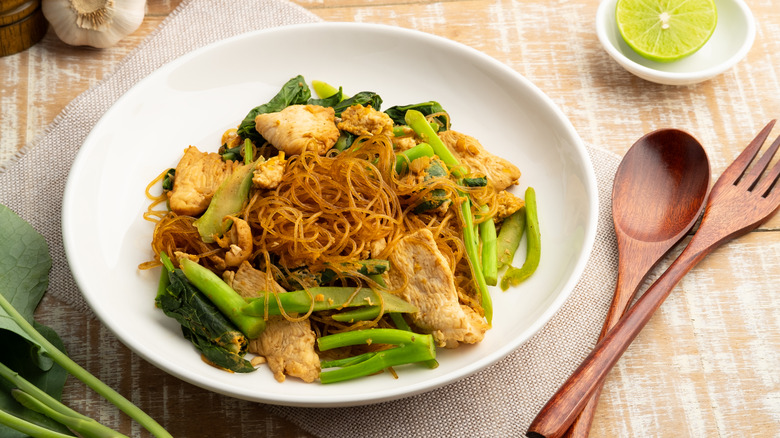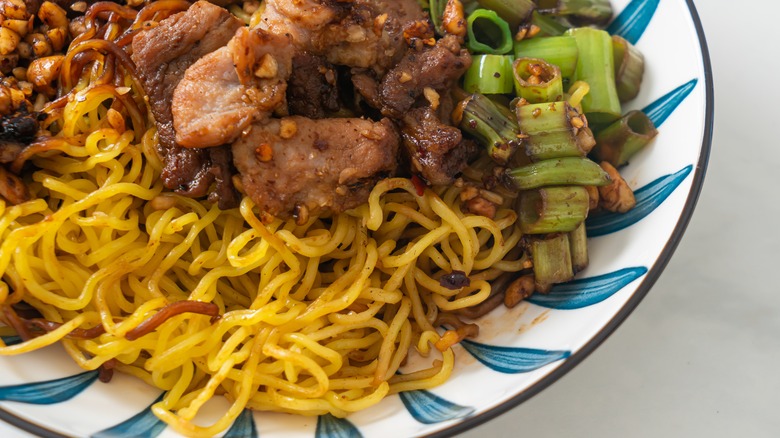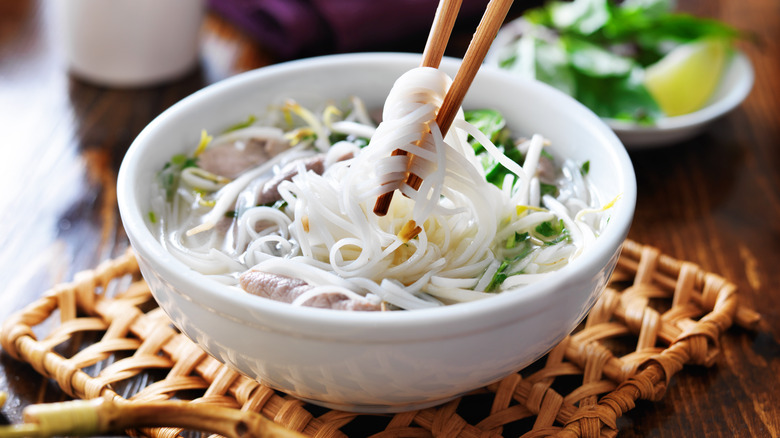Here's What It Means To Order Dry Thai Noodle Soup
Noodle soup stands are to Thailand what hot dog stands are to America: Specialty food vendors that focus on one food, excel at making it, and can be found far and wide. Thai noodle soup is consumed daily in Thailand and can be ordered with all kinds of customizations. Hungry customers choose between several kinds of noodles, broth, vegetables, spices, and toppings, making each bowl unique. One of the lesser-known (yet still popular) ways to order Thai noodle soup is dry.
When you order dry Thai noodle soup, known in Thailand as "haeng" noodle soup, you will get all the fixings that come with the type of noodle soup you order — it'll just be served without the broth. Instead, the broth is replaced with seasoning sauce, and the noodles serve as the dish's base. The result is a lighter meal that's still rich in the flavors of your soup's ingredients.
Ordering dry Thai noodle soup
To officially order dry Thai noodles, you'll want to ask for "haeng," which is the English spelling of "dry." You'll then be presented with ingredient options. Dry Thai soup can be made with a variety of noodles, one of which is rice noodles — these do the best job of picking up sauce without losing their texture. As for protein, meatballs and wontons are a great choice for your lighter dry noodles, but you can also order seafood or thinly sliced meats (typically pork). Tofu is not commonly used in authentic Thai noodle stands but can serve as a solid vegetarian alternative. Bean sprouts and bok choy are the vegetables that traditionally appear in Thai noodle soup, and the dishes often come topped with Thai basil and green onions — all of which add a fresh crunch.
Dry noodle soup is officially served with sauce that keeps the ingredients' moisture and flavor without the broth. Chicken Pad See Ew is an example of a dry noodle dish with sauce that uses oyster sauce, soy sauce, sugar, and vinegar to season the noodles. The sauce not only coats the noodles but also the meat and vegetables as they cook together, allowing all the flavors to meld. Like most dry noodle dishes, Pad See Ew has crunchy vegetables, the texture of which is preserved by the sauce and not made mushy by broth, one of the benefits of choosing "haeng."
What to expect from your dry Thai noodle soup
Once you've decided what to order, you can watch the magic happen as the chef combines your ingredients into a one-of-a-kind dry Thai noodle dish. Note that all of the ingredients are prepared separately, including the broth so your noodles aren't inherently soupy. This is good to know if you want to try making dry Thai noodles at home: Give love to each ingredient separately and combine them all in your bowl at the last minute — after all, this isn't a crock pot recipe. As for preparing your ingredients ahead of time, you'll want to pre-marinate your meats and, since you won't be using broth, cook the meats as well. This can be accomplished by cooking your meats in boiling water and then setting them aside, which is also how you'll blanch your vegetables to keep them vibrant.
The beauty of Thai noodle soups is that the broth is actually the last ingredient added (that's right, even after the spices and toppings). So, if you've made a batch of noodles at home and half of your party wants the full soup experience, simply add a ladle of broth to your prepared dry bowls and leave the others broth-less. The ingredients can be the same for both, but each person can customize their broth needs. This way, you can enjoy dishes like Thai coconut chicken soup a variety of ways.


